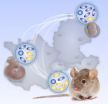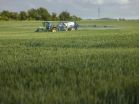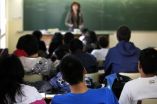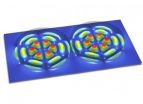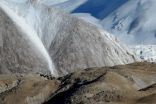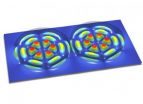(Press-News.org) Mitochondria are cell organelles located within animal and human cells. They produce energy for the organism, possess their own genetic material - mitochondrial DNA (mtDNA) - and are transmitted exclusively by the mother. Depending on their activity and tasks, different numbers of mitochondria are present in a cell - usually a few hundred to a thousand per body cell.
Inherited mitochondrial disorders or so-called mitochondropathies occur in about one of 10,000 humans throughout the world. Diseases such as diabetes, stroke, cardiac defects, epilepsy, or muscle weakness may originate from mitochondrial defects. Inherited mitochondrial disorders have been incurable so far. Therefore, efforts are now being made to enable women with this disease to bear healthy children by means of nuclear transfer.
Mitochondria multiply at different rates
Jörg Burgstaller, a scientist and member of Gottfried Brem's research group at the Vetmeduni Vienna, has been working for several years on the genetics of mitochondria. It was known before that different types of mitochondria within a cell can proliferate at different rates. However, it was not known whether this is a singular phenomenon or if these cases occur more frequently.
Burgstaller investigated this in four newly bred mouse models which carried different mixtures of mitochondria whose DNA were related to each other to a differing extent.
This meant no health problem for the mice since all mtDNAs are were fully functional.
The outcome was: the more distantly two types of mitochondria within an egg cell were related, the more frequently a growth advantage was noted in favor of one of the two types of mitochondria. When two different mtDNAs were equally common in cells of an organ at the time of birth, one type was completely lost after a while. One mitochondria variant had thus achieved a growth advantage compared to the other variant and superseded the latter. This effect was almost non-existent in genetically very similar mitochondria within the cells; the ratio between the two types of mitochondria was not altered in that case.
The effect is of significance in reproduction medicine
Burgstaller's results may have effects on the planned introduction of the so called "Three-Parent Baby" in Great Britain. Experts take the cell nucleus of one human egg cell whose mitochondria have a defect and place it in an egg cell with "healthy" mitochondria. The baby resulting from this procedure has three parents, namely the mother whose cell nucleus is used, the mother whose mitochondria are involved, and the father whose sperm inseminated the egg cell.
However, this method raises the following problem: in every nuclear transfer, a small number of defective mitochondria are transferred into the healthy egg cell. "So far it was believed that this minimal 'contamination' is of no consequence for the baby. However, our data show that the effect may have dramatic consequences on the health of the offspring. If the mitochondria of both mothers are genetically very different, it may have the same effects seen in the mouse model," says Burgstaller who developed the theory together with co-author Joanna Poulton, Professor of Mitochondrial Genetics at the John Radcliffe Hospital in Oxford. "One mitochondrial type may be able to assert itself against the other. If the assertive one happens to carry the defective mtDNA, the benefit of the therapy would be jeopardized."
The solution to the "Three-Parent Baby"-problem
Burgstaller and his colleagues suggest the following solution to the problem: the mtDNA of both mothers, i.e. the donor of the nucleus and the donor of the mitochondria, should be analyzed in advance and aligned to each other. So called "machting haplotypes" could prevent the dangerous effect. In the future the effect may even be utilized in a targeted manner to suppress defective mtDNA.
INFORMATION:
The work was conducted in cooperation with BIAT (Biomodels Austria) and the technology platform Vetcore at Vetmeduni Vienna, Joanna Poulton from John Radcliffe Hospital in Oxford, Jaroslav Piálek from the Czech Academy of Sciences, and Iain Johnston and Nick Jones from the Imperial College (London).
The article „mtDNA Segregation in Heteroplasmic Tissues Is Common In Vivo and Modulated by Haplotype Differences and Developmental Stage", by Joerg Patrick Burgstaller, Iain G. Johnston, Nick S. Jones, Jana Albrechtová, Thomas Kolbe, Claus Vogl, Andreas Futschik, Corina Mayrhofer, Dieter Klein, Sonja Sabitzer, Mirjam Blattner, Christian Gülly, Joanna Poulton, Thomas Rülicke, Jaroslav Piálek, Ralf Steinborn and Gottfried Brem was published in the journal Cell Reports. DOI:10.1016/j.celrep.2014.05.020 http://www.sciencedirect.com/science/article/pii/S2211124714003957
About the University of Veterinary Medicine, Vienna
The University of Veterinary Medicine, Vienna in Austria is one of the leading academic and research institutions in the field of Veterinary Sciences in Europe. About 1,200 employees and 2,300 students work on the campus in the north of Vienna which also houses five university clinics and various research sites. Outside of Vienna the university operates Teaching and Research Farms. http://www.vetmeduni.ac.at
Scientific Contact:
Dr. Joerg Burgstaller
of Veterinary Medicine Vienna (Vetmeduni Vienna)
T +43 1 25077-5639
M +43 664 3767262
joerg.burgstaller@vetmeduni.ac.at
Released by:
Susanna Kautschitsch
Science Communication / Public Relations
University of Veterinary Medicine Vienna (Vetmeduni Vienna)
T +43 1 25077-1153
susanna.kautschitsch@vetmeduni.ac.at
Three parents and a baby
Scientists advise caution with regard to artificial insemination method
2014-06-17
ELSE PRESS RELEASES FROM THIS DATE:
Chemical pollution of European waters is stronger than anticipated
2014-06-17
This news release is available in German.
Substantial improvements in freshwater quality by 2015 have been a declared objective of the EU member states, manifesting itself by the requirements of the Water Framework Directive (WFD). A recent study conducted by the Institute for Environmental Sciences Landau together with the Helmholtz Centre for Environmental Research (UFZ) and fellow scientists from France (University of Lorraine and EDF) and Switzerland (Swiss Federal Institute of Aquatic Science and Technology - EAWAG) shows that this target is unlikely to be ...
Social inequality intensifies amongst low-scoring pupils
2014-06-17
Children's marks at school influence the likelihood of them abandoning their studies, but the effect varies according to their social background: among students with poor marks, those from a higher social class have more opportunities to raise their marks than children of low-skilled workers. This is according to a study carried out by researchers from the National University of Distance Learning (UNED) and the European University Institute.
"The study deals with dissociating the effect of the marks (considered the 'primary source' of educational results) from other processes ...
Strange physics turns off laser
2014-06-17
Inspired by anomalies that arise in certain mathematical equations, researchers have demonstrated a laser system that paradoxically turns off when more power is added rather than becoming continuously brighter.
The finding by a team of researchers at Vienna University of Technology and Princeton University, could lead to new ways to manipulate the interaction of electronics and light, an important tool in modern communications networks and high-speed information processing.
The researchers published their results June 13 in the journal Nature Communications (Ref. 1).
Their ...
Study: In wild yak society, moms are the real climbers
2014-06-17
NEW YORK (June 17, 2014) – A new study led by the Wildlife Conservation Society says that in wild yak societies, it's the mothers that are the real climbers. The study found that mothers with young venture on steeper terrain and slightly higher elevation than either males or females without young.
The authors of the study expect that this strategy is an adaptive way to avoid predators and to access more nutritious food. Wild yaks are an endangered species occurring only on the Tibetan Plateau and closely related to North American bison.
The study, which appears in ...
Promising T cell therapy
2014-06-17
This news release is available in German. The cells of the human immune system are created from special stem cells in the bone marrow. In diseases affecting the bone marrow, such as leukemia, the degenerate cells must be destroyed using radiation or chemotherapy. Subsequently, the hematopoietic system has to be replaced with stem cells from the blood of a healthy donor. Because of the resulting temporary weakening of the immune system, patients are more exposed to viruses that would normally be warded off.
The cytomegalovirus (CMV), which can cause serious damage to ...
Laser physics upside down
2014-06-17
This news release is available in German.
Sound waves fade, water waves ebb, light waves are dissipated by a wall. The absorption of waves is a very common phenomenon. But only recently have physicists realized that amazing new possibilities are opened up, when this energy loss, rather than being seen as an annoying nuisance, is actually considered a desired effect. At the Vienna University of Technology, a system of two coupled lasers has been created, in which wave dissipation leads to a behaviour completely contrary to intuition: additional energy can switch it ...
Research at Granada finds that the eye's optical quality deteriorates after alcohol consumption
2014-06-17
A study conducted by the University of Granada has scientifically proven that alcohol consumption markedly impairs night-vision because it increases the perception of halos—luminous circles—and other visual night-time disturbances. Moreover, this deterioration of vision is significantly greater in subjects with breath alcohol content in excess of 0.25mg/litre—the legal limit for driving in Spain and other countries and, also, that recommended by the World Health Organization (WHO).
Researchers from the Laboratory of Vision Sciences and Applications conclude that alcohol ...
Does the moon affect our sleep?
2014-06-17
Popular beliefs about the influence of the moon on humans widely exist. Many people report sleeplessness around the time of full moon. In contrast to earlier studies, scientists from the Max Planck Institute of Psychiatry in Munich did not observe any correlation between human sleep and the lunar phases. The researchers analyzed preexisting data of a large cohort of volunteers and their sleep nights. Further identification of mostly unpublished null findings suggests that the conflicting results of previous studies might be due to a publication bias.
For centuries, people ...
How does a tree know it's time to grow again?
2014-06-17
Winter takes its toll on living things. To protect themselves from the elements, bears hibernate, and trees go dormant. Biologists have observed what happens when trees become dormant, but up to now, they haven't understood the underlying genetic mechanisms that enable them to start growing again.
Led by molecular geneticists from Michigan Technological University a gene has been identified and characterized that tells a poplar tree when winter ends and a spring growing season begins. Victor Busov, a professor in Michigan Tech's School of Forest Resources and Environmental ...
Long-term study suggests ways to help children learn language and develop cognitive skills
2014-06-17
Examining factors such as how much children gesture at an early age may make it possible to identify and intervene with very young children at risk for delays in speech and cognitive development, according to a new study by researchers at the University of Chicago.
The research by leading early learning scientists looked at children from a wide variety of backgrounds, including those from advantaged and disadvantaged families, and those who had suffered brain injury. Their work was published in an article, "New Evidence About Language and Cognitive Development Based on ...
LAST 30 PRESS RELEASES:
NTP-enhanced lattice oxygen activation in Ce-Co catalysts for low-temperature soot combustion
Synergistic interface engineering in Cu-Zn-Ce catalysts for efficient CO2 hydrogenation to methanol
COVID-19 leaves a lasting mark on the human brain
Scientists use ultrasound to soften and treat cancer tumors without damaging healthy tissue
Community swimming program for Black youth boosts skills, sense of belonging, study finds
Specific depressive symptoms in midlife linked to increased dementia risk
An ‘illuminating’ design sheds light on cholesterol
Who is more likely to get long COVID?
Study showcases resilience and rapid growth of “living rocks”
Naval Research Lab diver earns Office of Naval Research 2025 Sailor of the Year
New Mayo-led study establishes practical definition for rapidly progressive dementia
Fossil fuel industry’s “climate false solutions” reinforce its power and aggravate environmental injustice
Researchers reveal bias in a widely used measure of algorithm performance
Alcohol causes cancer. A study from IOCB Prague confirms damage to DNA and shows how cells defend against it
Hidden viruses in wastewater treatment may shape public health risks, study finds
Unlock the power of nature: how biomass can transform climate mitigation
Biochar reshapes hidden soil microbes that capture carbon dioxide in farmland
Reducing saturated fat intake shows mortality benefit, but only in high-risk individuals
Manta rays create mobile ecosystems, study finds
Study: Mixed results in using lipoic acid to treat progressive multiple sclerosis
Norbert Holtkamp appointed director of Fermi National Accelerator Laboratory
New agentic AI platform accelerates advanced optics design
Biologists discover neurons use physical signals — not electricity — to stabilize communication
Researchers discover that a hormone can access the brain by hitchhiking
University of Oklahoma researcher awarded funding to pursue AI-powered material design
Exploring how the visual system recovers following injury
Support for parents with infants at pediatric check-ups leads to better reading and math skills in elementary school
Kids’ behavioral health is a growing share of family health costs
Day & night: Cancer disrupts the brain’s natural rhythm
COVID-19 vaccination significantly reduces risk to pregnant women and baby
[Press-News.org] Three parents and a babyScientists advise caution with regard to artificial insemination method
